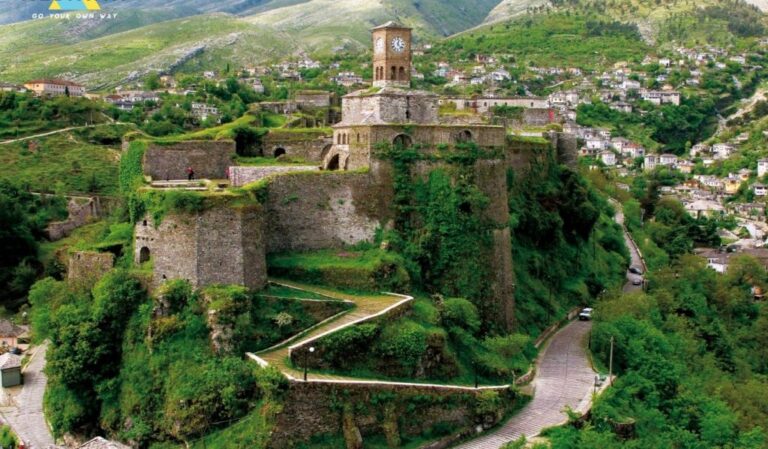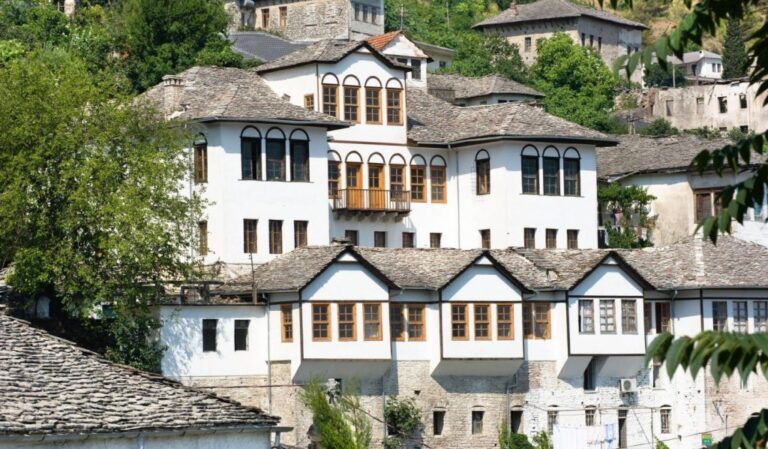




Gjirokastra, a city steeped in nearly fairy-tale charm, captivates with its steep, stone-paved streets where each building etches its own history in stone. Nestled in Southern Albania, Gjirokastra sprawls across the steep slopes of the Drino River valley, in a dominating position with a landscape rich in history.
Known as the “city of a thousand steps,” Gjirokastra encompasses hundreds of Ottoman-style tower houses with stone roofs, wooden balconies, and stone walls, sometimes whitewashed with lime. With its majestic castle perched on a steep hill, Gjirokastra is a magical city with a turbulent past, inscribed as a UNESCO World Heritage Site since 2005.
The city’s origins trace back to the Gjirokastra Castle, built in the 4th century AD. Known as the Castle of Argjiro, it is the city’s most significant structure and the largest in Albania. The city was named Argyrokastro in 1336. It reached its peak of prosperity between 1800-1830, during which the characteristic monumental houses were built.
Inside the castle, you can visit the Arms Museum, opened in 1971, displaying various weapons from prehistoric times to World War II. The castle has been hosting the National Folklore Festival of Gjirokastra for many years.
The Pazar Quarter and the Hazmurat Quarter were the first two quarters of the city. Gjirokastra’s main characteristic is the intensive use of stone in building houses that resemble small castles, the cobblestone streets, all leading to the Pazar. Here, you can also visit the Pazar Mosque, built in 1557. The historical area is the part of the city that attracts most tourists. As you descend towards “Çerçiz Square,” where the past and present sharply divide, your journey towards Gjirokastra’s undiscovered riches begins on the city’s most beautiful street, where the cobblestone motifs cannot escape the tourists’ eyes and cameras.
Some attractions in Pazar Quarter include Sokaku i të Marrëve, the reconstructed house of the great Albanian writer Ismail Kadare, the house of Zekatëve, perched on the mountain slope, and the house of Skëndulatëve.
In Gjirokastra, you can also visit cultural and natural heritage destinations.
The Antigonea Archaeological Park is located near Saraqinisht village in the Lunxhëria area, east of Gjirokastra. This park, 14 km from Gjirokastra, was founded by King Pyrrhus of Epirus in 295 BC. At Antigonea, attractions include mosaics, columns, walkways, an ancient weighbridge, surrounding walls, etc.
In the village of Labova e Kryqit, near the small city of Libohova, you can visit one of the oldest and most beautiful Byzantine churches in Albania, dedicated to Saint Mary. The church, built in a style similar to Saint Sophia in Istanbul, remains one of Gjirokastra’s most unique attractions.
During your tour in Gjirokastra, you can also visit the ancient theater of Hadrianopolis, located near the village of Sofratike, about 14 km from Gjirokastra along the Gjirokastra-Kakavija highway. This theater, dating back to the 2nd century BC, is one of the most interesting archaeological attractions.
For nature and adventure sports enthusiasts, Çajupi Field offers a great opportunity to relax in nature. Located in the Lunxheri area, surrounded by cold water springs and multicolored trees, this area with potential for mountain tourism development is ideal for hiking, horseback riding, meditation, etc.
Gjirokastra is also known for its culinary art, featuring unique dishes such as pasha qofte, shapkat, and oshaf with dried figs (a dessert made with sheep’s milk, sugar, and dried figs).
Customise your Albanian tour now!
Other Destinations
Get in touch with our friendly team
- contact@absolutealbania.com
- +355 67 40 567 56
